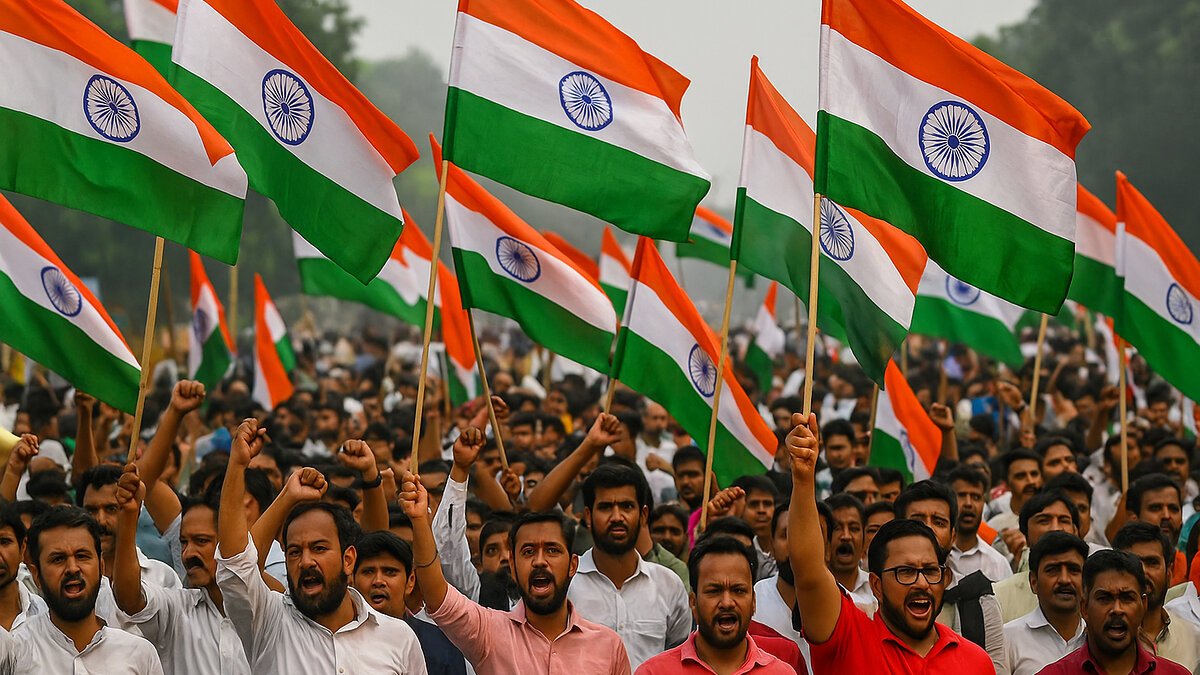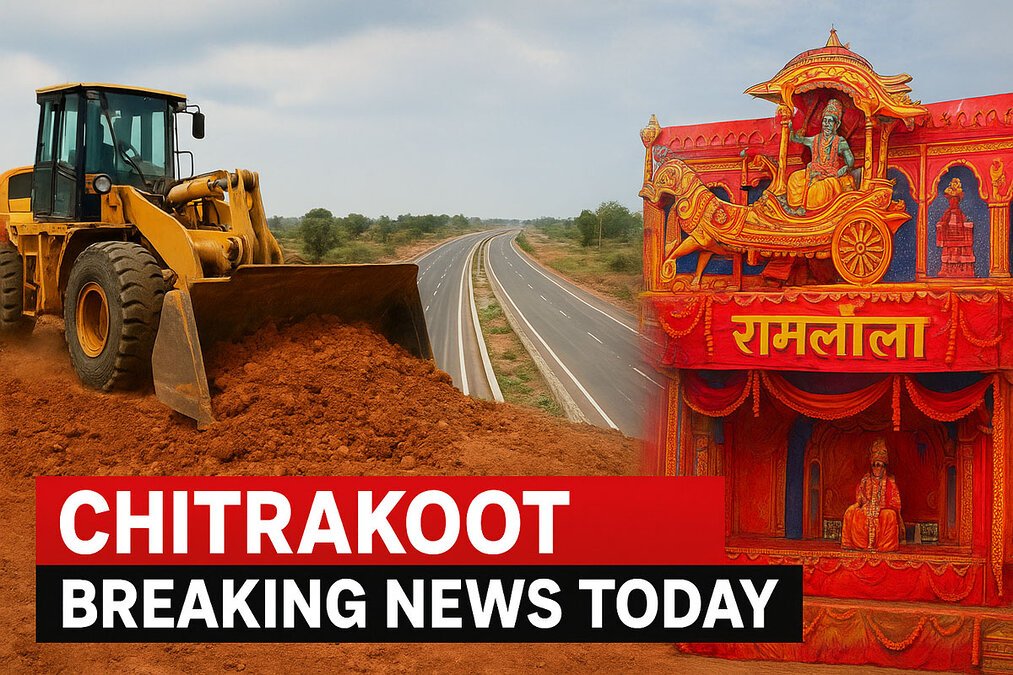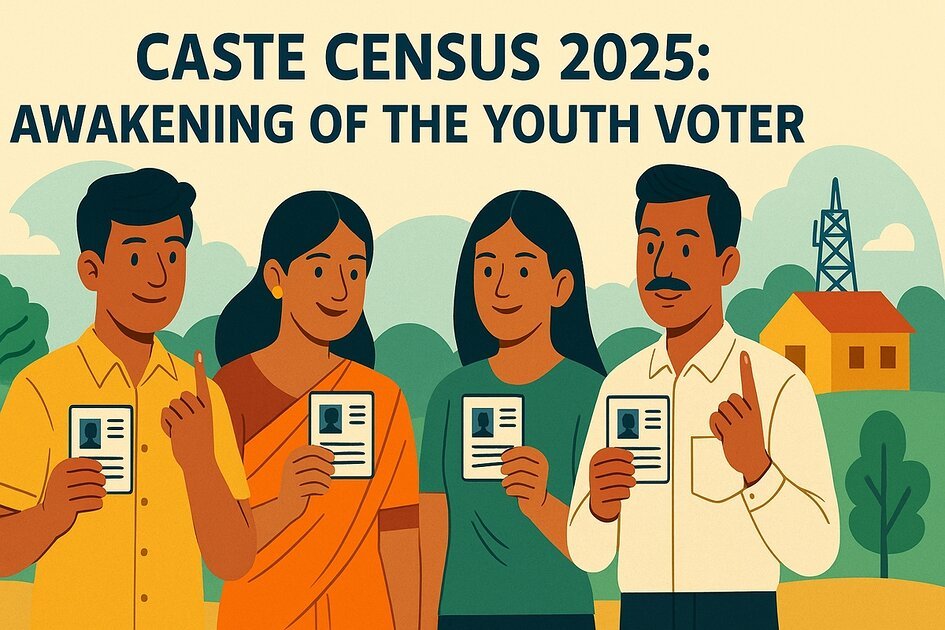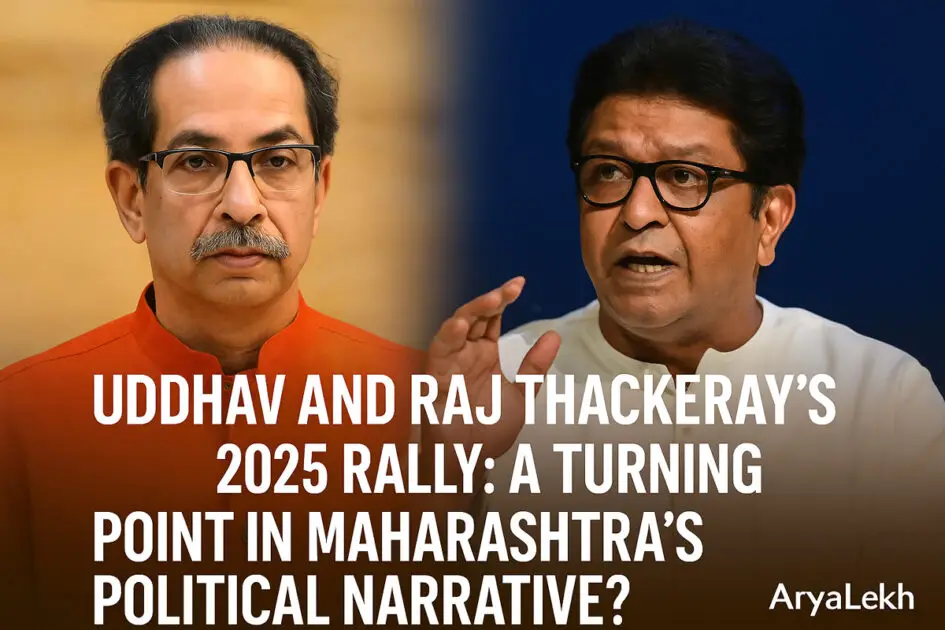Vote chori protest: On August 11, 2025, opposition MPs marching to the Election Commission in New Delhi were briefly detained; on August 12 they wore “124 Not Out” T-shirts to highlight a Siwan draft-roll typo listing a woman as 124 years old. On August 13, the Supreme Court said Bihar’s Special Intensive Revision (SIR) appears voter-friendly because it accepts 11 document types (vs 7) and remains in force while corrections proceed.
A single digit turned a routine update of India’s electoral rolls into a national talking point. The sight of MPs wearing “124 Not Out” T-shirts inside the Parliament complex was designed for instant recall: a number so implausible it demanded attention, a face so personal it reframed a process story into a people story. A day earlier, the INDIA bloc’s street march to the Election Commission of India (ECI) had ended in brief police detentions, creating imagery that always travels—barricades, slogans, and leaders being escorted into buses.
Beyond the theatre lie practical questions every voter should care about. What is the SIR? How did a wrong age make it to a draft roll? Does one glaring error prove systematic manipulation—or does it expose the everyday fragility of data entry at scale? Most importantly, what fixes would calm fears and make the rolls both accurate and inclusive in the weeks before Bihar heads to the polls?
This explainer answers those questions with clear timelines, definitions, and action-oriented solutions you can track.
What actually happened on August 11–12?
- August 11 (New Delhi): INDIA bloc MPs attempted to march from Parliament towards the ECI’s Nirvachan Sadan to protest alleged irregularities linked to Bihar’s SIR. Delhi Police stopped the march and briefly detained several leaders, including Rahul Gandhi. All were released the same day. The optics were exactly what the Opposition wanted: a confrontation that showcased urgency and grievance.
- August 12 (Parliament complex): The protest moved from roads to visuals. Opposition MPs donned white T-shirts with a woman’s face and the line “124 Not Out.” The phrase referred to a draft voter-roll entry in Siwan district that listed a first-time voter as 124 years old. The image and number did what symbols do best—compress a complex administrative exercise into a single, shareable outrage.
Together, those two days created the narrative spine of the controversy: a street clash, a detention tableau, and a punchy slogan linking alleged errors to alleged “vote chori.”
SIR 101: What it is—and why it happens
India’s electoral roll is not a one-and-done database. It is a living list that must be continuously updated: removing deceased voters, adding those who turned 18, reflecting migration, and correcting names, ages, and addresses. A Special Intensive Revision (SIR) is a time-bound, deeper-than-routine audit undertaken when stakes are high—typically before elections—or when a state needs more than a standard summary revision.
What the SIR seeks to do in Bihar:
- Additions: Enroll new eligible voters, especially first-timers who crossed 18 or were previously missed.
- Corrections: Fix data errors—misspelled names, wrong ages, incorrect addresses, misassigned booths.
- Deletions (with due process): Remove entries for deceased or migrated voters, ensuring the integrity of the list.
What’s different this time: In hearings on August 13, the Supreme Court noted that Bihar’s SIR allows 11 types of supporting documents to establish eligibility, compared with 7 under routine summary revision. On paper, a longer list of acceptable proofs should expand inclusion by giving citizens more ways to demonstrate they are eligible to vote.
The tension: Petitioners challenging the process argue that document penetration in some Bihar districts is uneven. If a poor household has none of the commonly held documents, inclusion remains theoretical. The Court called this the “trust deficit” problem—rules may be inclusive; outcomes depend on how they’re implemented on the ground.

Vote chori protest : The “124 Not Out” case – what the number actually tells us
The entry: A draft roll from Siwan showed Minta Devi as 124 years old.
The administrative explanation: District authorities describe it as a clerical error—a wrong birth year captured during application—now under correction.
The individual’s stance: The woman concerned, around 35, has objected to the use of her name and photograph in political messaging without her consent and has asked that her records be fixed.
What this proves—and doesn’t: The mis-age confirms weak validation and a slow correction loop at some stage of data handling. By itself, it does not prove a statewide conspiracy or mass “vote theft.” Politically, however, it is devastating optics: one face, one absurd number, a perfect emblem for distrust.
Vote chori protest: Why it mattered instantly:
- Simplicity: Anyone can understand that 124 is impossible for a first-time voter.
- Personalization: A real woman’s face made the issue human.
- Timing: Surfaced the day after detentions, it amplified the Opposition’s message.
The Supreme Court’s early stance—and what it implies
On August 13, a bench of Justices Surya Kant and Joymalya Bagchi heard arguments on Bihar’s SIR. Four clear points emerged:
- No stay: The SIR is not stayed. The process continues under judicial scrutiny.
- Voter-friendly on paper: The 11 document options (versus 7 in a routine revision) suggest an inclusionary design.
- Trust deficit: The obstacle is not only the rulebook; it is execution. Citizens must experience inclusion—help desks, mobile camps, and fast corrections—not just read about it in circulars.
- Conditional guardrails: If credible evidence of mass exclusion surfaces, the Court signaled it could intervene without derailing the election calendar.
Implication for administrators: Publish measurable proof that the widened document basket translates into actual enrollments and corrections—especially among document-poor households.
Constitutional Awareness at India’s Tipping Point: Choose Democracy Over Propaganda
Vote chori protest: Myths, realities, and the middle truth
Myth 1: “One absurd entry proves mass fraud.”
Reality: A single error proves poor quality control, not a conspiracy. Every large database produces outliers. The real question is whether anomalies form patterns that disproportionately affect specific communities or constituencies.
What to watch: District-wise error density and whether corrections are evenly distributed.
Myth 2: “More document options automatically mean inclusion.”
Reality: On paper, yes. In practice, access depends on whether citizens can produce or replace those documents in time. Without door-to-door facilitation and clear guidance, expanded options can still leave people out.
What to watch: Help-desk footfall, mobile-van schedules, and approval rates for applicants with minimal paperwork.
Myth 3: “Detentions prove the protest was illegal.”
Reality: In Delhi, brief preventive detentions during marches are common for crowd-control and permit reasons. They are not judicial rulings on the merits of a protest.
What to watch: Whether protest routes and permissions are codified to lower the temperature without muting dissent.
Myth 4: “Typos are harmless—someone will fix them.”
Reality: In tight races, a single digit can erase a voter, misassign a booth, or delay a first ballot.
What to watch: Turnaround time on corrections and whether districts meet a 48–72-hour service-level during the draft window.
Myth 5: “Transparency is a press note.”
Reality: Transparency is live, granular data—how many corrections were requested, approved, rejected, and pending in each block, updated daily until the final roll.
Why South India is Better for Women Than North India in 2025 – Safety, Education & Equality Facts

The practical spine of a fair roll: validation and redress
If institutions want to move the conversation from accusation to assurance, seven fixes matter more than any slogan:
- Automated anomaly flags
Configure the roll-management system to auto-hold entries with implausible ages (e.g., >110), duplicate EPICs, or improbable household sizes. These must be manually verified before any draft is published. - Public correction dashboards
Launch a simple, mobile-friendly dashboard showing block-wise counts of corrections filed, resolved, and pending. Update it daily during the claims-and-objections window to build confidence. - Mobile help vans and enrollment camps
Equip vans with document scanners, affidavit templates, and trained staff. Prioritize low-documentation localities and hard-to-reach habitations; publish weekly routes so citizens know when help arrives. - Multilingual, proactive communication
Use SMS/IVR, WhatsApp broadcasts, and printed notices to explain which documents are accepted, how to fix errors, and where to go. Ensure helplines answer promptly and record ticket numbers. - Strict SLAs for corrections
Guarantee 48–72 hours for straightforward typo fixes during the draft window. Publish escalation contacts and automatically alert applicants once changes are applied. - Third-party spot audits
Invite retired civil servants, accredited civil-society organisations, or recognized academic institutions to conduct randomized checks on the ground. Publish their one-page summaries each week. - Booth-level social verification (with safeguards)
Where documentation is thin, allow community attestations by local officials or recognized community representatives, backed by penalties for false statements. This prevents the paper-poor from being left out while deterring abuse.
None of these steps are partisan. They are plumbing—and good plumbing prevents leaks of trust.
Regenerative Farming in India: 7 Powerful Breakthroughs Transforming Agriculture
Questions that still demand answers
- Scale: How many age, address, and duplicate anomalies did the draft identify in each district? Do error rates cluster by block or demographic?
- Speed: What share of reported errors are corrected within three days? Where are the bottlenecks?
- Access: How many mobile vans and camps were deployed last week? How many first-time voters were enrolled through them?
- Appeals: If a correction request is rejected, what is the appeal timeline and success rate?
- Transparency: Will the CEO Bihar/ECI publish a weekly bulletin with district-wise addition/deletion/correction tallies until final rolls?
- Privacy: After the Siwan episode, are there clear rules against using a citizen’s name or photograph in political material linked to roll errors without consent?
These are not hostile questions. They are democratic hygiene—the practical checks that turn trust from a promise into a deliverable.
The path ahead: beyond August optics
Draft rolls are a waypoint, not the destination. Bihar’s schedule moves next into the claims and objections phase, culminating in final rolls targeted for late September 2025. If Bihar is to head into polls with confidence:
- Administrators must lean into radical transparency and last-mile facilitation—dashboards, vans, helplines, and time-bound corrections.
- Opposition parties should pair symbolism with ground-level assistance, staffing help desks that file real applications and track outcomes.
- Media and civil society can maintain a public scoreboard of corrections and anomalies, turning anecdote into data that voters can see.
Do that, and the oxygen for sweeping “vote chori” allegations diminishes. Fail, and every clerical bruise will be read as a deliberate wound.
Democracies rarely collapse in spectacular fashion. They erode in the gap between inclusive intentions and incomplete implementation. Bihar’s SIR—like any mass data exercise—will be judged by three metrics: the integrity of validation, the speed of correction, and the willingness to show the numbers. The “124 Not Out” T-shirt distilled a truth: small errors look big when trust is small. The remedy is not fewer revisions; it is better revisions—measured by inclusion achieved, errors fixed, and citizens satisfied.
FAQs
Is the SIR paused by the Supreme Court?
No. As of August 13, 2025, there is no stay on Bihar’s SIR. The Court has noted that allowing 11 document types instead of 7 is, in principle, voter-friendly, while emphasizing the need to bridge the trust deficit through effective execution.
Were leaders actually detained on August 11?
Yes. During the march from Parliament towards the ECI, police briefly detained several opposition leaders, including Rahul Gandhi, and released them later the same day.
What’s the truth behind “124 Not Out”?
It refers to a clerical error in Siwan, where a draft record listed a woman as 124 years old because of an incorrect birth year. Officials say the entry is being corrected. The woman has also objected to her name and photo being used without consent.
Does one glaring error prove rigging?
No. One error proves quality-control failure. To establish rigging, you would need systematic patterns across constituencies that consistently favor or exclude specific groups. The decisive evidence would be anomaly clusters, delayed fixes, and biased rejections—not a single mis-age.
When are Bihar’s final voter rolls expected?
After the claims-and-objections phase, the state targets late September 2025 for final publication. Citizens should continue to file corrections and track status through official channels until then.
AryaLekh (DoFollow) : Click Here
- Luxury Beauty Lifestyle 2025: 12 Proven Upgrades for an Effortless, Powerful Glow
- Beauty Parlor Industry 2025: Prices, GST, Hygiene & Growth Trends
- Digital Detox 2025: Proven Ways Students Can Boost Focus, Sleep, and Mental Clarity
- Digital Youth 2025: How Technology Shapes Young Minds and the Global Push for Mental Health Solutions
- Honey Rose Actress Biography – Grace, Strength & Impact
- Why South India is Better for Women Than North India in 2025 – Safety, Education & Equality Facts









